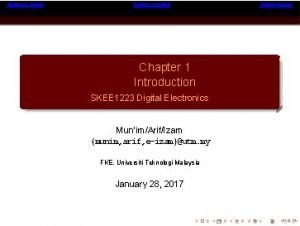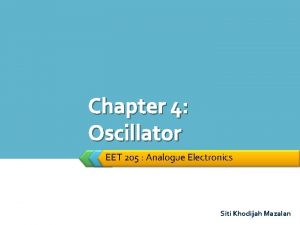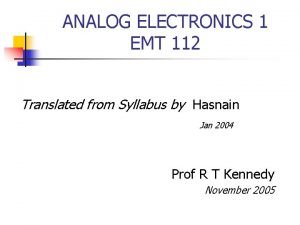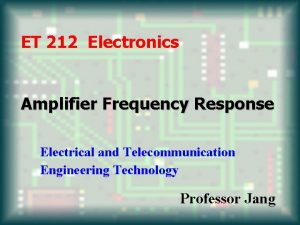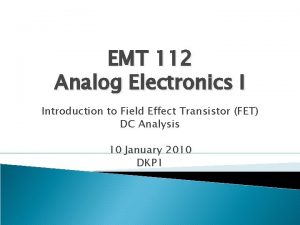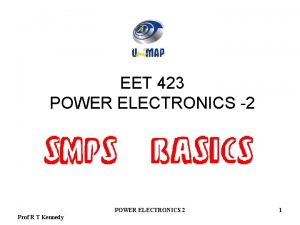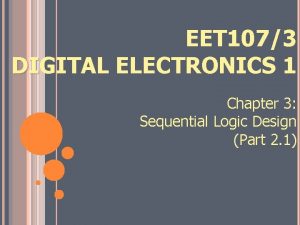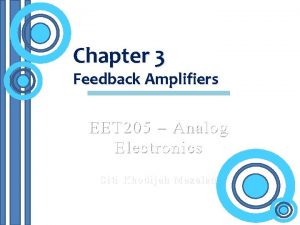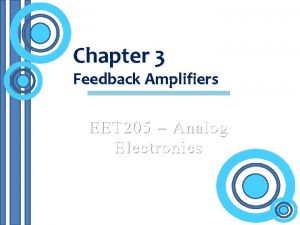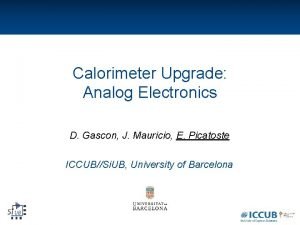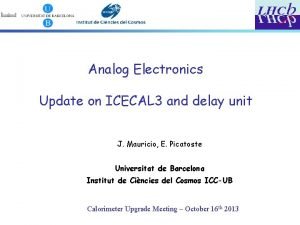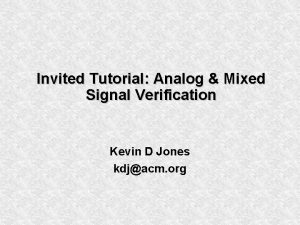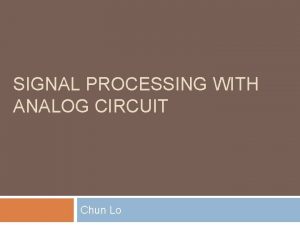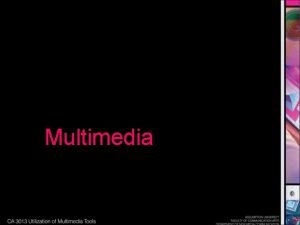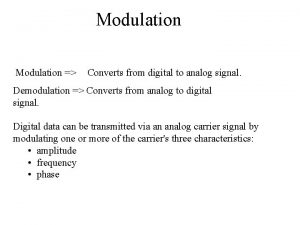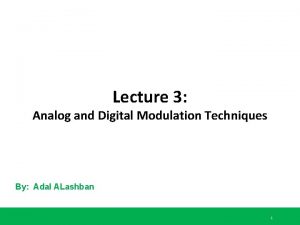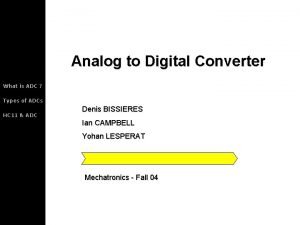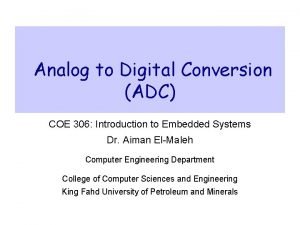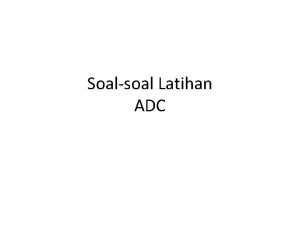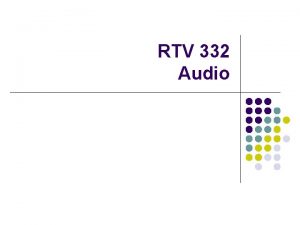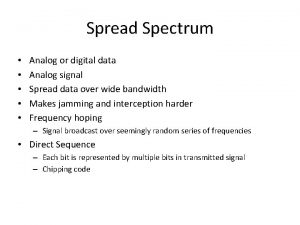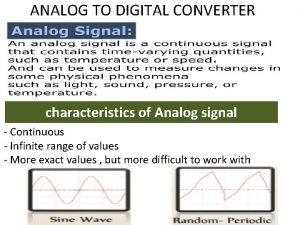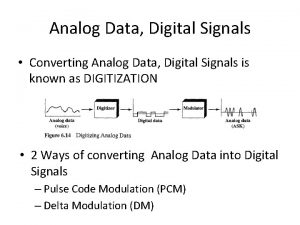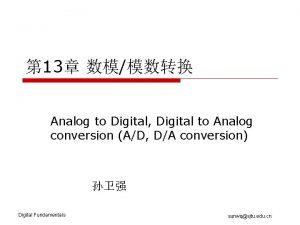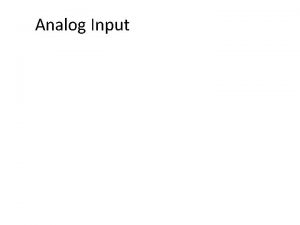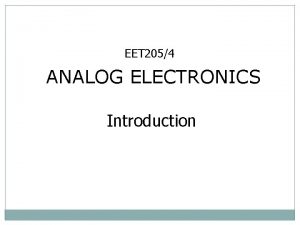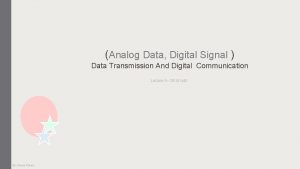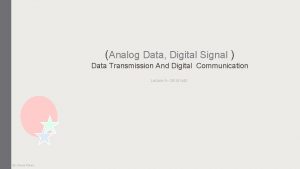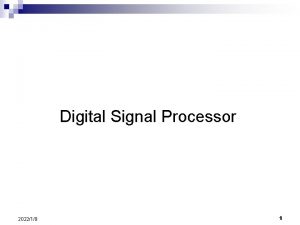Digital Coding of Analog Signal Electronics Engineering Department




































- Slides: 36

Digital Coding of Analog Signal Electronics Engineering Department, Sardar Vallabhbhai National Institute of Technology, Surat-395007. Prepared By: Amit Degada Teaching Assistant

Outline • Analog To Digital Converter • Review of sampling – – – Nyquist sampling theory: frequency and time domain Alliasing Bandpass sampling theory Natural Sampling Aperture Effect – – – Quantization Error. Companding. Two optimal rules A law/u law • Quantization • Coding • Differential PCM

Claude Elwood Shannon, Harry Nyquist

Sampling Theory • In many applications it is useful to represent a signal in terms of sample values taken at appropriately spaced intervals. • The signal can be reconstructed from the sampled waveform by passing it through an ideal low pass filter. • In order to ensure a faithful reconstruction, the original signal must be sampled at an appropriate rate as described in the sampling theorem. – A real-valued band-limited signal having no spectral components above a frequency of FM Hz is determined uniquely by its values at uniform intervals spaced no greater than (1/2 FM) seconds apart.

Sampling Block Diagram • Consider a band-limited signal f(t) having no spectral component above B Hz. • Let each rectangular sampling pulse have unit amplitudes, seconds in width and occurring at fs(t) interval of T seconds. f(t) A/D conversion T Sampling

Sampling

Impulse Sampling with increasing sampling time T

Introduction EE 541/451 Fall 2006

Math

Math, cont.

Interpolation Formula

Interpolation If the sampling is at exactly the Nyquist rate, then

Under Sampling, Aliasing

Avoid Aliasing • Band-limiting signals (by filtering) before sampling. • Sampling at a rate that is greater than the Nyquist rate. f(t) Anti-aliasing filter A/D conversion T Sampling fs(t)

Practical Interpolation Sinc-function interpolation is theoretically perfect but it can never be done in practice because it requires samples from the signal for all time. Therefore real interpolation must make some compromises. Probably the simplest realizable interpolation technique is what a DAC does.

Natural sampling (Sampling with rectangular waveform)

Bandpass Sampling • A signal of bandwidth B, occupying the frequency range between f. L and f. L + B, can be uniquely reconstructed from the samples if sampled at a rate f. S : f. S >= 2 * (f 2 -f 1)(1+M/N) where M=f 2/(f 2 -f 1))-N and N = floor(f 2/(f 2 -f 1)), B= f 2 -f 1, f 2=NB+MB.

Time Division Multiplexing • Entire spectrum is allocated for a channel (user) for a limited time. • The user must not transmit until its k 1 k 2 k 3 k 4 k 5 k 6 next turn. • Used in 2 nd generation c Frequency f t • Advantages: – Only one carrier in Time the medium at any given time – High throughput even for many users – Common TX component design, only one power amplifier – Flexible allocation of resources (multiple time slots).

Quantization • Scalar Quantizer Block Diagram

Quantization Procedure

Quantization Error

Quantization Type Mid-tread Mid-rise


Quantization Noise

Quantization Noise • What happens if no. of representation level increases? • >64 distortion is significant • Quantization error is uniformly distributed in interval (-∆/2 to ∆/2). • The Avg. Power of Quantizing error qe

Math K∆+ ∆/2 K∆ Pq qe K∆- ∆/2 Sample of Amplitude K∆+ qe 0 V

Example • A sinusoidal Signal of amplitude Am uses all Representation levels provided for Quantization in the case of full load condition. Calculate Signal to Noise ratio in db assuming the number of quantization levels to be 512. • ANS: 55. 8 db.

Example • SNR for varying number of representation levels for sinusoidal modulation 1. 8+6 X d. B Number of representati on level L 32 64 128 256 Number of Bits per Sample, R 5 6 7 8 SNR (d. B) 31. 8 37. 8 43. 8 49. 8

Companding • Process of uniform Quantization is not possible. • Example: Speech, Video. • The variation in power from weak signal to powerful signal is 40 db. • So Ratio 1000: 1 • Excursion in Large amplitude occurs less frequently. • This Scenario is cared by Non- Uniform Quantization.

Non-uniform Quantizer F: nonlinear compressing function F-1: nonlinear expanding function F and F-1: nonlinear compander X y F Example F: y=log(x) Q ^ y F-1 ^ x F-1: x=exp(x) We will study nonuniform quantization by PCM example next A law and law

Input-Output characteristic of Compressor

Law/A Law • The -law algorithm (μ-law) is a companding algorithm, primarily used in the digital telecommunication systems of North America and Japan. Its purpose is to reduce the dynamic range of an audio signal. In the analog domain, this can increase the signal to noise ratio achieved during transmission, and in the digital domain, it can reduce the quantization error (hence increasing signal to quantization noise ratio). • A-law algorithm used in the rest of worlds. • A-law algorithm provides a slightly larger dynamic range than the mu-law at the cost of worse proportional distortion for small signals. By convention, A-law is used for an international connection if at least one country uses it.

Law

A Law EE 541/451 Fall 2006

Implementation of Compander • Diode equation • Piece-wise linear Approach

Coding
 Digital signal as a composite analog signal
Digital signal as a composite analog signal Apa itu selective coding
Apa itu selective coding Apa itu open coding
Apa itu open coding Digital vs analog signal
Digital vs analog signal Analog vs digital chips
Analog vs digital chips Oscillator analog electronics
Oscillator analog electronics Syllabus of analog electronics
Syllabus of analog electronics Frequency response cbe
Frequency response cbe Emt 112
Emt 112 Analog electronics
Analog electronics 3 bit up down counter using t flip flop
3 bit up down counter using t flip flop Analog electronics
Analog electronics Analog electronics
Analog electronics Eet 205
Eet 205 Analog electronics
Analog electronics Icecal
Icecal Digital encoding schemes
Digital encoding schemes Analog mixed signal verification
Analog mixed signal verification Disadvantages of dpcm
Disadvantages of dpcm Precision analog signal processing
Precision analog signal processing History of qualitative research
History of qualitative research Coding dna and non coding dna
Coding dna and non coding dna Department of electronics & information technology
Department of electronics & information technology Latest electronic and information technology in odisha
Latest electronic and information technology in odisha Compare and contrast weather
Compare and contrast weather Perbedaan teknologi digital dan analog
Perbedaan teknologi digital dan analog Digital vs analog transmission
Digital vs analog transmission Analog v digital
Analog v digital Modulation digital to analog
Modulation digital to analog Disadvantages of fsk
Disadvantages of fsk Analog and digital video
Analog and digital video Amw huebsch
Amw huebsch Analog to digital converter types
Analog to digital converter types Analog to digital converter
Analog to digital converter Pengertian adc dan dac
Pengertian adc dan dac Contoh soal sinyal analog
Contoh soal sinyal analog Digital vs analog sound
Digital vs analog sound




